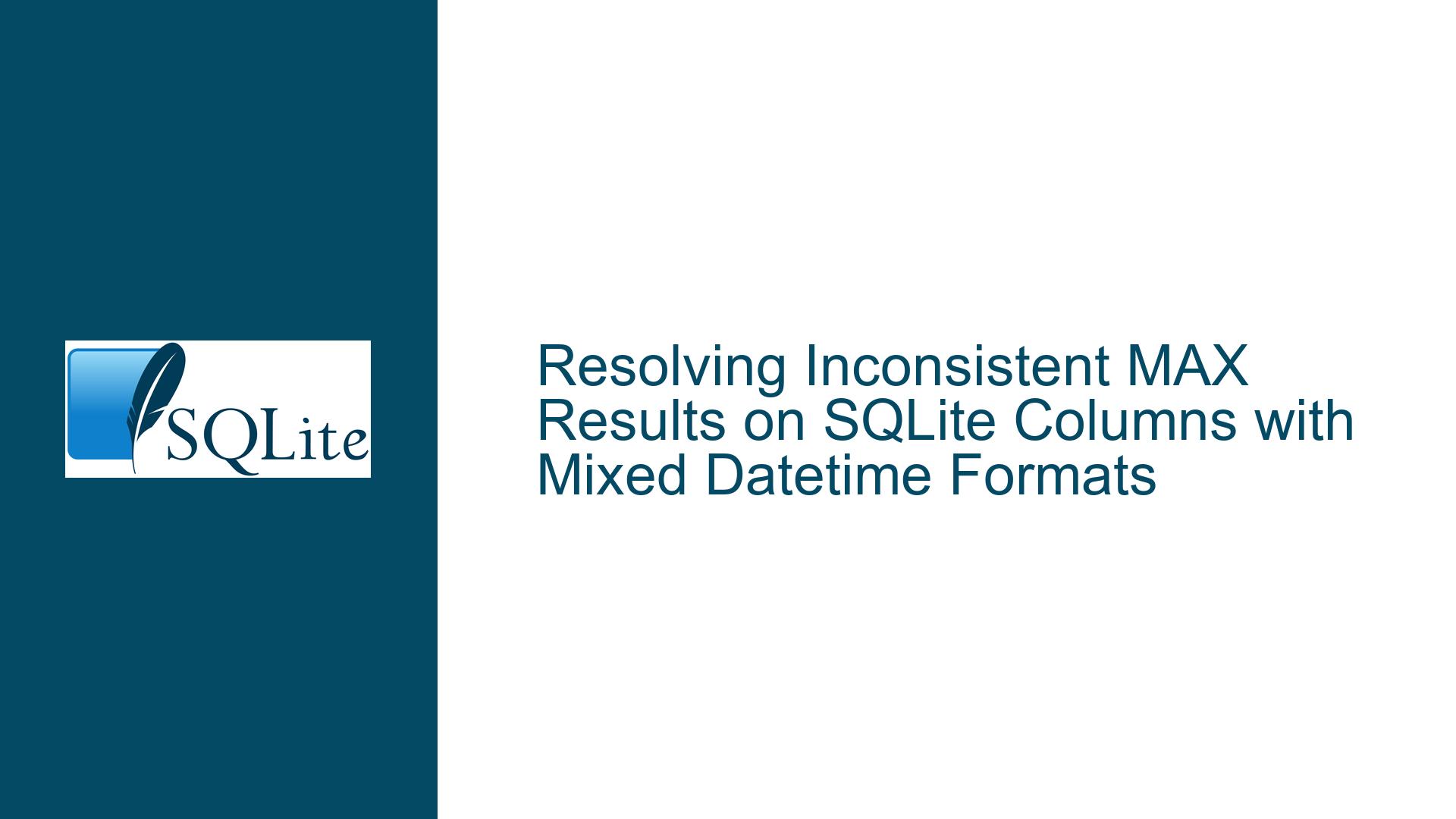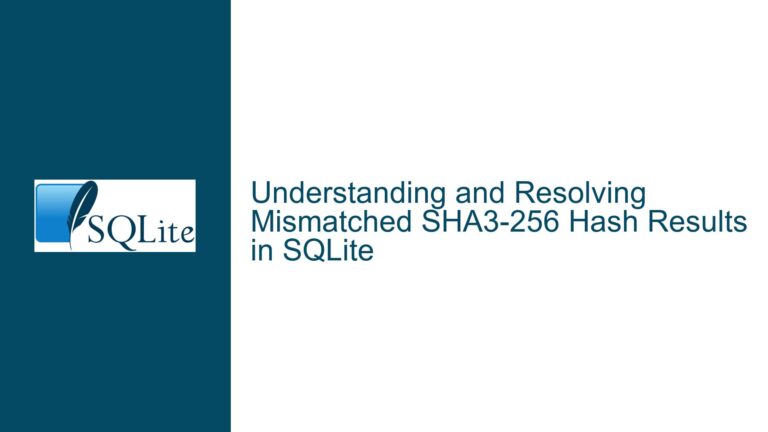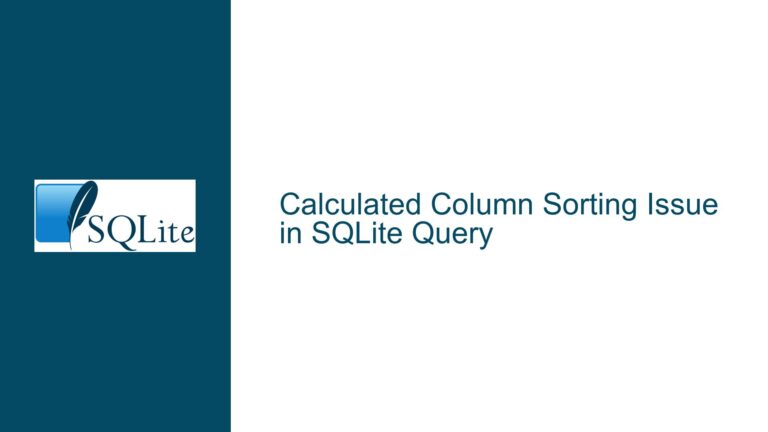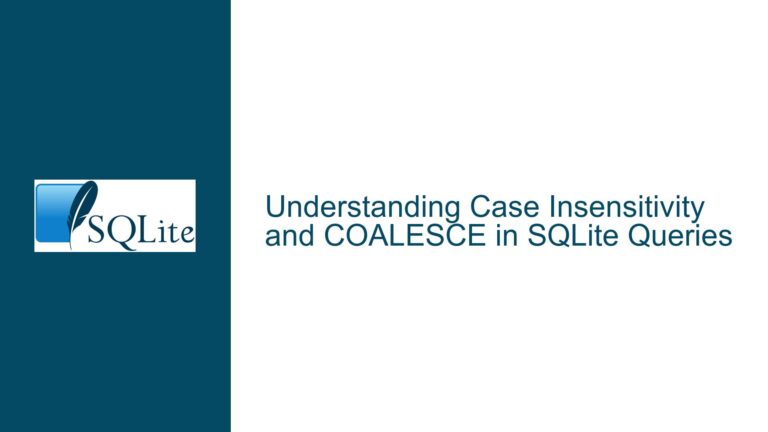Resolving Inconsistent MAX Results on SQLite Columns with Mixed Datetime Formats
Understanding Mixed Datetime Formats and MAX() Behavior in SQLite
Issue Overview: Conflicting Results from MAX() on Datetime Values Stored as Strings and Numbers
The core problem revolves around how SQLite handles mixed data formats in a column declared with a datetime type affinity. In the provided scenario, ExampleTable.datetimeField contains values stored in two distinct formats:
- ISO-8601 date/time strings (e.g.,
'2022-04-22 10:30:34'). - Julian Day numbers (e.g.,
478694.2,5758694.2).
When executing SELECT MAX(datetimeField), SQLite returns '2022-04-22 10:30:39', but when using MAX(julianday(datetimeField)), it returns 2778694.2. The confusion arises because these results appear contradictory: one suggests the latest timestamp is in 2022, while the other implies a date in the distant future (2895).
Key Observations:
- SQLite does not enforce strict data types. The
datetimeaffinity is a hint, not a constraint. - Values in
datetimeFieldare stored as eitherTEXT(ISO-8601) orREAL(Julian Day). - The
MAX()function respects SQLite’s sorting rules, where data types are compared hierarchically:NULL<INTEGER/REAL<TEXT<BLOB. - When comparing mixed types,
TEXTvalues always rank higher thanREALorINTEGER. Thus,MAX(datetimeField)selects the largestTEXTvalue lexicographically, ignoring numeric entries. - The
julianday()function converts all values toREAL, allowingMAX()to compare them numerically.
This discrepancy highlights SQLite’s reliance on stored representation rather than semantic meaning when evaluating aggregates. The root issue is the coexistence of incompatible datetime formats in a single column, leading to ambiguous interpretations of "maximum" depending on the query’s context.
Possible Causes: Type Affinity Ambiguity and Datetime Representation Mismatches
Type Affinity Misapplication
Declaring a column asdatetimedoes not enforce storage in a specific format. SQLite’s type affinity system only influences how values are stored, not validated. For example:'2022-04-22 10:30:34'is stored asTEXT.478694.2is stored asREAL.
Queries operate on the stored types, not the intended semantic meaning.
Mixed Datetime Formats
Mixing ISO-8601 strings and Julian Day numbers creates a fractured dataset:- ISO-8601 strings are human-readable but compared lexicographically. For example,
'2023-01-01'is considered "greater than"'2022-12-31'lexicographically. - Julian Day numbers represent dates as fractional days since noon UTC on November 24, 4714 BC. These are numeric and comparable mathematically.
Without normalization,
MAX()operates on raw stored values, not parsed dates.- ISO-8601 strings are human-readable but compared lexicographically. For example,
Function-Driven Type Conversion
Functions likejulianday(),strftime(), anddate()alter how values are interpreted:julianday('2022-04-22 10:30:34')converts the ISO string to aREAL(e.g.,2459695.9378935).julianday(478694.2)treats the number as a precomputed Julian Day, returning it unchanged.
Applying such functions homogenizes the data type, enabling consistent comparisons but potentially misinterpreting numbers not intended as Julian Days.
Application-Side Type Casting Failures
The Free Pascal driver’s error ("Impossible to cast the value to TDateTime") stems from the result ofMAX(julianday(datetimeField))being aREAL, which the driver cannot map to aTDateTimetype. This occurs because:- The column’s affinity does not guarantee the result type.
- Aggregate functions like
MAX()return the same storage class as their input. Usingjulianday()forces aREALresult, which the driver may not handle.
Troubleshooting Steps and Solutions: Normalizing Datetimes and Ensuring Consistent Queries
Step 1: Standardize Datetime Storage Format
Problem: Mixing formats prevents reliable comparisons.
Solution: Choose a single datetime representation for the column:
Option A: Store All Dates as ISO-8601 Strings
Convert Julian Day numbers to ISO-8601 before insertion:INSERT INTO ExampleTable (id, datetimeField) VALUES (3, strftime('%Y-%m-%d %H:%M:%f', 478694.2));Advantages:
- Human-readable.
- Lexicographical order matches chronological order.
Option B: Store All Dates as Julian Day Numbers
Convert ISO-8601 strings to Julian Days:INSERT INTO ExampleTable (id, datetimeField) VALUES (1, julianday('2022-04-22 10:30:34'));Advantages:
- Numeric comparisons are mathematically accurate.
- Supports fractional seconds and arithmetic operations.
Step 2: Use Explicit Conversion in Queries
If altering existing data is impractical, homogenize formats during querying:
For ISO-8601-Centric Workflows:
Convert Julian Day numbers to ISO strings usingstrftime():SELECT MAX(strftime('%Y-%m-%d %H:%M:%f', datetimeField)) FROM ExampleTable;Caveat: This fails if
datetimeFieldcontains non-numeric strings (e.g.,'invalid-date').For Julian-Day-Centric Workflows:
Convert ISO strings to Julian Days usingjulianday():SELECT MAX(julianday(datetimeField)) FROM ExampleTable;Caveat: Assumes all
TEXTvalues are valid ISO-8601 dates.
Step 3: Validate and Clean Existing Data
Identify rows with incompatible formats:
-- Find non-ISO strings:
SELECT * FROM ExampleTable
WHERE typeof(datetimeField) = 'text'
AND datetimeField NOT GLOB '????-??-?? ??:??:??*';
-- Find numbers outside plausible Julian Day ranges:
SELECT * FROM ExampleTable
WHERE typeof(datetimeField) = 'real'
AND (datetimeField < 1721425.5 OR datetimeField > 5373484.5);
(Julian Day 1721425.5 corresponds to 1 AD, and 5373484.5 to 9999 AD.)
Step 4: Address Application-Side Casting Errors
Modify queries to return a consistent type:
-- Return ISO-8601:
SELECT strftime('%Y-%m-%d %H:%M:%f', MAX(julianday(datetimeField)))
FROM ExampleTable;
-- Return Julian Day:
SELECT MAX(julianday(datetimeField))
FROM ExampleTable;
In Free Pascal, use explicit type casting based on the expected format:
Query.SQL.Text := 'SELECT strftime("%Y-%m-%d %H:%M:%f", MAX(julianday(datetimeField))) FROM ExampleTable';
Query.Open;
DateTimeValue := Query.Fields[0].AsString; // Handle as string
// Or parse manually if using TDateTime:
DateTimeValue := ISO8601ToDate(Query.Fields[0].AsString);
Step 5: Enforce Data Integrity with Constraints
Prevent future inconsistencies using CHECK constraints:
CREATE TABLE ExampleTable (
id INTEGER,
datetimeField DATETIME
CHECK (
(typeof(datetimeField) = 'text' AND datetimeField GLOB '????-??-?? ??:??:??*')
OR
(typeof(datetimeField) = 'real' AND datetimeField BETWEEN 1721425.5 AND 5373484.5)
)
);
Final Recommendations:
- Normalize Early: Convert all datetime values to a single format during insertion.
- Query Consistently: Use
julianday()orstrftime()to ensure type homogeneity in aggregates. - Validate Rigorously: Use constraints and application checks to reject invalid dates.
By aligning storage formats with query logic, you eliminate ambiguity in SQLite’s flexible type system and ensure reliable results from MAX() and other aggregates.






